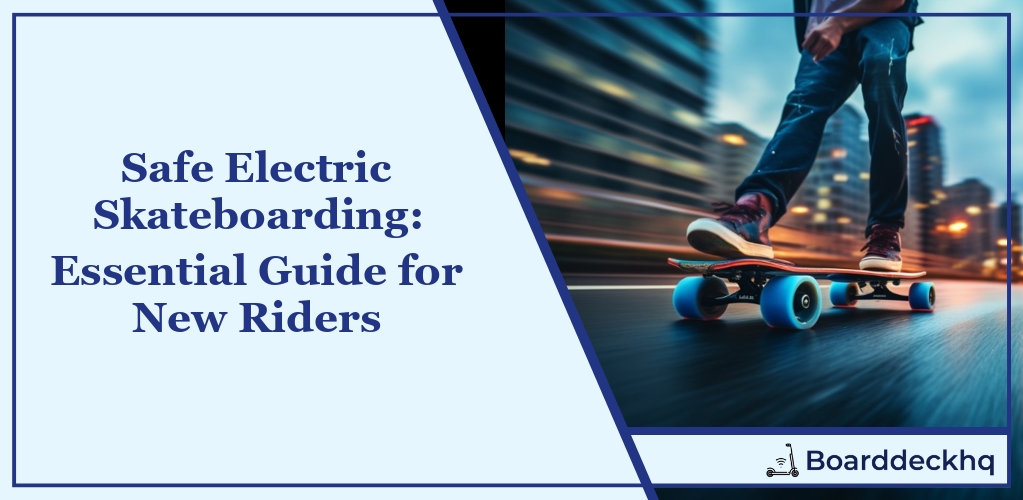Imagine gliding smoothly and effortlessly down the street on your sleek and stealthy electric skateboard. The thrill and freedom that come with this innovative mode of transport are unparalleled. But what about safety? In this comprehensive guide for beginners, we delve into the world of electric skateboarding and the essential steps to ensure a safe ride every time.
What we’ll cover:
- Understanding Electric Skateboarding
- Essential Safety Equipment
- Learning To Ride
- Safety Precautions
- Road and Traffic Rules
- Skateboard Maintenance
- Role of Technology and Remote Control
- Common Injuries and Preventive Measures
Are you ready to embrace the adventure that electric skateboarding offers, while also prioritizing safety? Let’s jump right in, and discover why wearing a helmet is just the beginning!
Understanding Electric Skateboarding and Its Risks
When you think about getting around town, what’s the first thing that comes to mind? If you’re into alternative methods of transportation, chances are electric skateboarding is high on your list. The thrill of zipping down the street, coupled with the convenience of a compact, portable ride, makes for an irresistible combination. But let’s not forget about safety.
While riding an electric skateboard can be fun and efficient, the risks cannot be ignored. Every time you step on that board, you expose yourself to potential dangers. Accidents caused by electric skateboards are not uncommon. Potholes, sharp turns, or even a tiny pebble can lead to a nasty fall. Pavement rushing to meet your face is not a pleasant experience, and serious injuries can result from such incidents.

Assessing Risks: From Minor Bruises to Serious Injuries
It’s not just about falling off your board. High speeds, especially in crowded areas or near roads with other vehicles, can lead to collisions. You’re not only risking your own safety but also that of others around you. What might seem like an innocent ride through the park can quickly turn into a trip to the emergency room if you lose control at the wrong time.
Equipment Essentials for Safe Electric Skateboarding
When it comes to electric skateboarding, the right protective gear plays an integral role in keeping you safe. Think of it as your personal shield against the brutal reality of concrete and asphalt.
Helmets: Your First Line of Defense
If you want to stay safe while skateboarding, always wear a helmet. It’s non-negotiable. Your head is one of the most vulnerable parts of your body, and a good helmet can be the difference between a minor injury and a life-altering accident.
What makes a helmet good? It should fit snugly on your head without being too tight or uncomfortable. Look for ones that meet safety standards and feature shock-absorbing layers.
Other Protective Gear: Knee Pads, Elbow Pads, Wrist Guards, and Gloves
But a helmet isn’t enough. Knee pads and elbow pads protect these joints from scrapes and fractures in case of a fall. Wearing a helmet and knee pads elbow pads will offer more comprehensive protection.
Wrist guards help prevent sprains and fractures, which are common among skaters, especially beginners who tend to break their fall with their hands. Gloves offer added protection for your hands and can provide better grip on the board’s controls.
By wearing all this protective gear, you’re creating a barrier between you and potential accidents. It might feel cumbersome at first, but protective gear wearing becomes second nature with time.

Mastering the Basics: Learning To Ride an Electric Skateboard
Skateboarding is an art form, and electric skateboarding is its modern twist. But like any art form, it takes practice and dedication to master. As a beginner, electric skateboarding safety should be at the forefront of your mind.
Practicing Patience: Taking It Slow
Learning to ride an electric skateboard doesn’t happen overnight. It’s easier to learn when you start slow and gradually build up your skills. The first few rides may seem daunting, but with time and patience, your balance and control will improve.
Understanding the Mechanism: Skateboards vs Electric Skateboards
When you ride an electric skateboard, it’s essential to understand how it differs from a standard skateboard. Electric skateboards come with motors that control speed and braking. So instead of pushing off with your foot, you’re using a remote to control your movements.
By taking the time to learn the ins and outs of riding an electric skateboard, you’ll become more confident and safer on the board over time. Remember to always consider your environment when you ride your electric skateboard — look out for pedestrians, vehicles, and potential obstacles in your path.

Important Safety Precautions while Electric Skateboarding
Electric skateboarding is a thrilling pastime, but ensuring safety is paramount. Riding an electric skateboard requires a certain level of skill, and as a beginner, there are several safety precautions you should bear in mind to stay safe.
Understanding Road Surfaces
The first safety tip revolves around understanding the importance of the road surface for electric skateboarding. Not all terrains are suitable for riding an electric skateboard. Smooth, flat surfaces are the most ideal, as rough or uneven roads can lead to accidents. You should also be aware of slippery conditions that can affect your ability to control the board.
Helmet Requirements
Helmets are non-negotiable when it comes to riding an electric skateboard. They offer crucial protection for your head in case of a fall or collision. While it might seem like a no-brainer, beginners often neglect this vital safety gear. Make sure that your helmet fits properly and is securely fastened before you start your ride.
Defensive Driving
Defensive driving for electric skateboarders is another essential aspect to staying safe while riding an electric skateboard. It involves being aware of your surroundings, anticipating potential dangers, and reacting appropriately. For example, you should always maintain a safe distance from vehicles and other road users and be ready to stop or change direction if necessary.
Child Safety
Lastly, child safety in electric skateboarding is particularly noteworthy. While it’s great to see young ones embracing this sport, they need to be extra careful when riding. Parents should ensure their children are wearing appropriate protective gear and are supervised at all times.

Navigating Road and Traffic Rules for Electric Skateboarding
Being on an electric skateboard does not exempt you from obeying traffic rules. In fact, understanding and adhering to these regulations is a significant part of being safe while riding an electric skateboard.
Traffic Rules
Traffic rules for electric skateboarders vary depending on your location, but some general principles apply universally. You should always follow traffic signals and signs, ride in the same direction as traffic, and yield to pedestrians. These rules not only keep you safe but also contribute to a harmonious co-existence with other road users.
Lane Safety
Lane safety for electric skateboarders is another important facet of riding etiquette for electric skateboarders. Try to stick to dedicated bike lanes where available, and avoid busy roads where cars move at high speeds. If you must use a car lane, stay as far right as possible unless you’re preparing to make a left turn.

Dealing with High Speeds and Braking System
Riding at high speeds on an electric skateboard has its own set of challenges. Understanding the nuances of these higher speeds and the braking system can help prevent injuries and accidents.
Understanding Electric Skateboard Brakes
Electric skateboard brakes work differently from those in traditional skateboards. You need to be familiar with how they operate to safely ride your electric skateboard. Most electric skateboards have a braking system controlled by a handheld remote. Always practice stopping gradually rather than slamming on the brakes to prevent losing control or being thrown off balance.
Traffic Collisions and Speed Control
Understanding electric skateboard traffic collisions is crucial in learning to navigate high speeds. Collisions often occur because riders can’t stop in time or fail to spot obstacles promptly. This points to the importance of speed control in electric skateboarding. Always keep your speed at a level where you can stop safely when needed.
In essence, being safe while riding an electric skateboard involves understanding your equipment, following rules and guidelines, and staying aware and controlled at all times. So next time you hop on your board, remember these tips and enjoy your ride responsibly.

Maintenance and Checks for Your Electric Skateboard
One of the major ways to ensure safety while using an electric skateboard is through regular maintenance and checks. The value of a well-maintained skateboard cannot be overstated, especially when it comes to boosting safety while riding.
The heart of electric skateboards lies in the bearings. When you maintain your electric skateboard regularly, the bearings continue to function optimally, ensuring smooth and steady rides. Additionally, regular maintenance helps to detect early signs of wear in the bearings, and replacements can be done before any major problems occur.
Wheel maintenance is another crucial aspect of electric skateboards. The wheels should be checked regularly for any cracks, tears, or signs of excessive wear. If you spot any issues, it’s a good idea to replace the wheels immediately to prevent accidents. Regular wheel maintenance ensures your ride is always smooth and safe.
Another vital part to check your electric skateboard is its battery. Battery safety in electric skateboards is paramount; they should always be charged using the correct charger, and never left unattended while charging. Be sure to check for any signs of swelling or leaks, and consult a professional if any defects are discovered.
Lastly, overheating prevention is also important to maintain your electric skateboard. Excessive heat can damage the batteries and other sensitive parts of the skateboard. Therefore, always avoid leaving your skateboard in direct sunlight for prolonged periods, and after long rides, give it some time to cool down before charging.

By choosing to maintain your electric skateboard, you’re choosing safety. The next time you check your skateboard, remember these tips — they might just save you from an unnecessary accident.
Role of Technology and Remote Control in Safety
Advancements in technology have played a huge role in improving safety for electric skateboard riders. For instance, today’s electric skateboards are equipped with advanced systems that help riders control their speed, brake efficiently, and maneuver through different terrains safely.
One of the most significant advancements has been the introduction of remote controls. A remote control for an electric skateboard allows the rider to control the speed of the board without having to physically touch it. This hands-free operation reduces distractions and makes it easier to navigate around obstacles. The ability to control your skateboard’s speed at the push of a button provides a significant boost to safety while riding.
In addition to all this, it’s essential to practice riding with the remote control on a regular basis. This promotes familiarity with the controls and makes it easier for riders to make quick decisions when necessary.
Furthermore, transportation engineering has also contributed to safety in electric skateboarding. Modern skateboards are designed with wide decks and grip tape for stability, shock-absorbing wheels for smoother rides, and regenerative braking systems for efficient stops. All of these innovations are working in the background to help keep you safe while you ride!
Understanding Common Injuries and Preventive Measures
When it comes to electric skateboarding, understanding common injuries and knowing how to prevent them can significantly enhance safety. Accidents can lead to serious injuries such as traumatic brain injuries from electric skateboarding or even fractures.
Head injuries are some of the most common and dangerous injuries associated with electric skateboarding. To prevent head injuries from electric skateboarding, always wear a certified skateboard helmet that fits snugly on your head and covers the back of your head fully. Additionally, knee injuries are also quite frequent due to falls or sudden stops. Therefore, wearing protective gear such as knee pads, as well as elbow pads and wrist guards should never be optional but a must for every rider. Moreover, learning how to fall correctly can also be extremely beneficial.
Lastly, remember that understanding how these injuries can occur is a step closer towards preventing them. Therefore, stay informed about possible dangers and always take all necessary precautions while riding your electric skateboard. Safety should always be your top priority!

Closing Thoughts
While electric skateboarding is an exciting and convenient mode of transport, it also carries certain risks. An understanding of these risks and the role of essential safety equipment cannot be overstated for safely navigating this adventure sport. Learning to ride an electric skateboard goes beyond mastering the basics, it also involves a comprehensive knowledge of safety precautions while skating and the ability to competently navigate road and traffic rules.
At high speeds, managing the braking system becomes paramount, necessitating regular maintenance and checks on your electric skateboard. With technology playing a significant role in enhancing safety measures through tools like remote control, it’s essential to be well-versed in its operation. Following the advice in this guide will ensure that you can maximize the thrill of electric skateboarding, without compromising on safety. Happy skating!
Frequently Asked Questions
Is it easy for beginners to learn how to ride an electric skateboard?
Learning to ride an electric skateboard may pose some challenges for beginners, particularly when getting used to the board’s speed and balance. However, with consistent practice and adherence to safety measures, it can become easier over time.
What kind of equipment is necessary for safe electric skateboarding?
For safe electric skateboarding, it’s crucial to have a quality helmet, knee and elbow pads, and wrist guards. All these items contribute to protecting the rider from potential injuries during falls or accidents.
How do traffic rules apply to me when I’m on my skateboard?
When you’re on your electric skateboard, regular traffic rules apply to you just like any other vehicle on the road. This includes obeying stop signs, traffic lights, and giving right-of-way where necessary. Always ensure you are familiar with your local laws regarding skateboarding on public roads.
How often should I maintain my electronic skateboard?
Maintenance frequency for your electronic skateboard may depend on how often you use it. However, a general rule is to check it after every ride for any damage or wear and tear, and conduct a comprehensive maintenance every few months.
How does weather affect my ability to ride my electronic skateboard?
Weather plays a significant role in electric skateboarding. For instance, rain might make surfaces slippery, reducing grip and increasing the risk of sliding. Snow can similarly affect traction and visibility. Therefore, always check the weather forecast before going on a ride.

